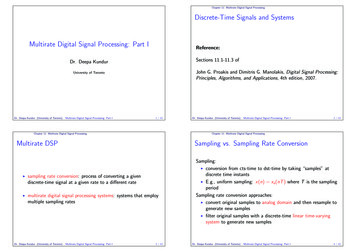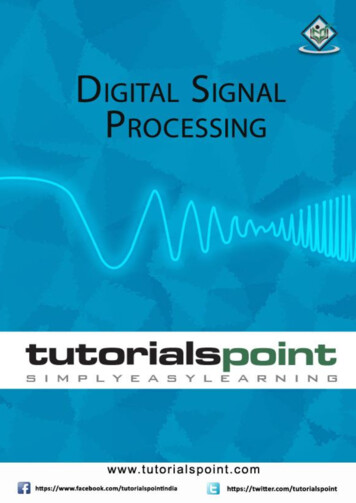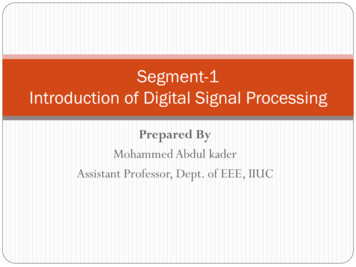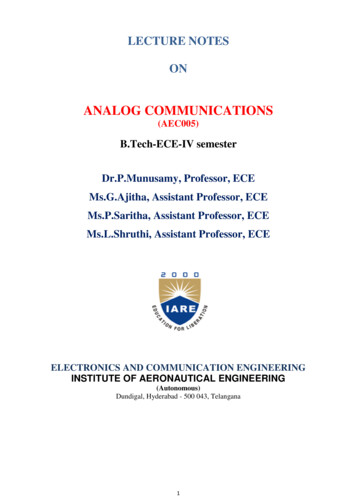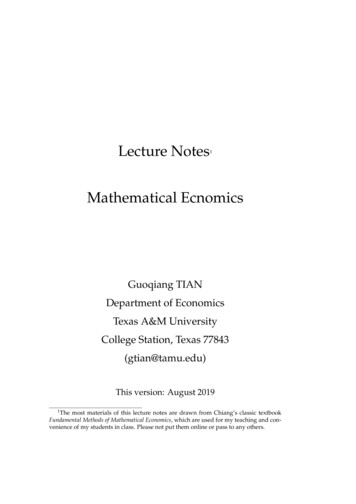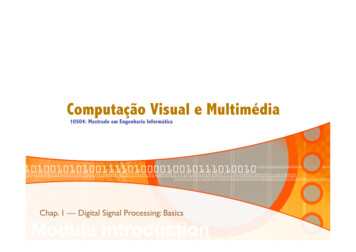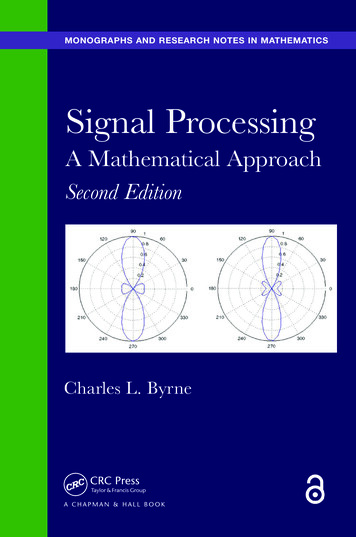
Transcription
MONOGRAPHS AND RESEARCH NOTES IN MATHEMATICSSignal ProcessingA Mathematical ApproachSecond EditionCharles L. Byrne
Signal ProcessingA Mathematical ApproachSecond Edition
MONOGRAPHS AND RESEARCH NOTES IN MATHEMATICSSeries EditorsJohn A. BurnsThomas J. TuckerMiklos BonaMichael RuzhanskyChi-Kwong LiPublished TitlesIterative Optimization in Inverse Problems, Charles L. ByrneSignal Processing: A Mathematical Approach, Second Edition, Charles L. ByrneModeling and Inverse Problems in the Presence of Uncertainty, H. T. Banks, Shuhua Hu,and W. Clayton ThompsonSinusoids: Theory and Technological Applications, Prem K. KytheBlow-up Patterns for Higher-Order: Nonlinear Parabolic, Hyperbolic Dispersion andSchrödinger Equations, Victor A. Galaktionov, Enzo L. Mitidieri, and Stanislav PohozaevSet Theoretical Aspects of Real Analysis, Alexander B. KharazishviliSpecial Integrals of Gradshetyn and Ryzhik: the Proofs – Volume l, Victor H. MollForthcoming TitlesStochastic Cauchy Problems in Infinite Dimensions: Generalized and RegularizedSolutions, Irina V. Melnikova and Alexei FilinkovMonomial Algebra, Second Edition, Rafael VillarrealGroups, Designs, and Linear Algebra, Donald L. KreherGeometric Modeling and Mesh Generation from Scanned Images, Yongjie ZhangDifference Equations: Theory, Applications and Advanced Topics, Third Edition,Ronald E. MickensMethod of Moments in Electromagnetics, Second Edition, Walton C. GibsonThe Separable Galois Theory of Commutative Rings, Second Edition, Andy R. MagidDictionary of Inequalities, Second Edition, Peter BullenActions and Invariants of Algebraic Groups, Second Edition, Walter Ferrer Santosand Alvaro RittatorePractical Guide to Geometric Regulation for Distributed Parameter Systems,Eugenio Aulisa and David S. GilliamAnalytical Methods for Kolmogorov Equations, Second Edition, Luca LorenziHandbook of the Tutte Polynomial, Joanna Anthony Ellis-Monaghan and Iain MoffatApplication of Fuzzy Logic to Social Choice Theory, John N. Mordeson, Davendar Malikand Terry D. ClarkMicrolocal Analysis on Rˆn and on NonCompact Manifolds, Sandro Coriasco
Forthcoming Titles (continued)Cremona Groups and Icosahedron, Ivan Cheltsov and Constantin ShramovSpecial Integrals of Gradshetyn and Ryzhik: the Proofs – Volume ll, Victor H. MollSymmetry and Quantum Mechanics, Scott CorryLineability and Spaceability in Mathematics, Juan B. Seoane Sepulveda, Richard W. Aron,Luis Bernal-Gonzalez, and Daniel M. PellegrinaoLine Integral Methods and Their Applications, Luigi Brugnano and Felice IavernoReconstructions from the Data of Integrals, Victor PalamodovLineability: The Search for Linearity in Mathematics, Juan B. Seoane SepulvedaPartial Differential Equations with Variable Exponents: Variational Methods andQuantitative Analysis, Vicentiu RadulescuComplex Analysis: Conformal Inequalities and the Bierbach Conjecture, Prem K. Kythe
MONOGRAPHS AND RESEARCH NOTES IN MATHEMATICSSignal ProcessingA Mathematical ApproachSecond EditionCharles L. ByrneUniversity of Massachusetts LowellLowell, Massachusetts, USA
FirstFirst editionedition publishedpublished inin 20052005 byby AAKK Peters,Peters, Ltd.Ltd.First edition published in 2005 by A K Peters, Ltd.CRCCRC PressPressTaylorTaylor && FrancisFrancis GroupGroup60006000 BrokenBroken SoundSound ParkwayParkway NW,NW, SuiteSuite 300300BocaRaton,FL33487-2742Boca Raton, FL 33487-2742 20152015 byby TaylorTaylor && FrancisFrancis Group,Group, LLCLLCCRCCRC PressPress isis anan imprintimprint ofof TaylorTaylor && FrancisFrancis Group,Group, anan InformaInforma businessbusinessNoCRCPresstoNo claimclaimto originaloriginal U.S.U.S. GovernmentGovernment worksworksTaylor & Francis GroupPrintedonpaper6000BrokenSound ParkwayPrintedon acid-freeacid-freepaper NW, Suite onDate:20140730InternationalStandardBookNumber-13: 2015 by Taylor& FrancisLLC mber-13:978-1-4822-4184-6 (Hardback)(Hardback)CRC Press is an imprint of Taylor & Francis Group, an Informa businessThisThis bookbook containscontains informationinformation obtainedobtained fromfrom authenticauthentic andand highlyhighly regardedregarded sources.sources. ReasonableReasonable riginalGovernmentworkshavebeentomademadeto U.S.publishreliable datadataand information,information, butbut thethe authorauthor andand publisherpublisher cannotcannot assumeassumeresponsibilityresponsibility forfor thethe validityvalidity ofof allall materialsmaterials oror thethe consequencesconsequences ofof theirtheir use.use. TheThe authorsauthors andand publisherspublishersPrintedon acid-freepaperhavetothehave attemptedattemptedto tracetracethe copyrightcopyright holdersholders ofof allall materialmaterial reproducedreproduced inin thisthis publicationpublication andand apologizeapologize totoVersionDate:20140730copyrightholdersifif permissioncopyrightholderspermission toto publishpublish inin thisthis formform hashas notnot beenbeen obtained.obtained. IfIf anyany copyrightcopyright materialmaterial hashasnotnot beenbeen acknowledgedacknowledged pleaseplease writewrite andand letlet usus knowknow soso wewe maymay rectifyrectify inin anyany futurefuture reprint.reprint.International Standard Book Number-13: 978-1-4822-4184-6 opartofthisbookmaybereprinted,Except as permitted under U.S. Copyright Law, no part of this book may be reprinted, reproduced,reproduced, transmittransmitThisbook containsinformationobtained fromauthentic andhighly regardedsources. hereafterReasonable effortsted,ted, oror utilizedutilized inin anyany formform byby anyany electronic,electronic, mechanical,mechanical, oror otherother means,means, nownow knownknown oror hereafter meincludingincluding photocopying,photocopying, microfilming,microfilming, andand recording,recording, oror inin anyany informationinformation storagestorage oror retrievalretrieval system,system,responsibilityforpermissionthe validityfromof allmaterialsor the consequences of their use. The authors and publisherswithoutwrittenthepublishers.without written permission from the publishers.have attempted to trace the copyright holders of all material reproduced in this publication and apologize tocopyrightholderspermissionorpublishin thisform has notbeenthisobtained.If any accesscopyrightmaterial hasFortomaterialelectronicallyfromwork,For sematerialelectronicallyfromthiswork, pleasepleaseaccess www.copyright.www.copyright.notacknowledged please writeorandlet us theknowso we mayrectify inCenter,any ntactthe ), 222222 RosewoodRosewoodDrive,Drive, Danvers,Danvers, MAMA 01923,01923, 978-750-8400.978-750-8400. CCCCCC isis aa not-for-profitnot-for-profit organizationorganization thatthat providesprovides licenseslicenses andandExceptas permittedunderofU.S.Law, noof this beenbook may be reprinted,reproduced,transmitThe ailableatpartwww.taylorfrancis.com,has been madeavailableunder aregistrationregistration forfor aa varietyvariety ofof users.users. ForFor organizations thatthat havehave been grantedgranted aa photocopyphotocopy licenselicense byby thethe CCC,CCC,ted,or utilizedin anyAttribution-Nonform by any beenelectronic,mechanical,or other means,now known or hereafter invented,CommonsCommercial-NoDerivatives4.0 license.aCreativea separateseparate systemsystem ofof paymentpayment hashas been arranged.arranged.including photocopying, microfilming, and recording, or in any information storage or retrieval system,withoutwrittenpermissionthe Notice:Productfromor corporatecorporatenames maymay bebe trademarkstrademarks oror registeredregistered trademarks,trademarks, andand areare usedusedonlyonly forfor identificationidentification andand explanationexplanation withoutwithout intentintent toto infringe.infringe.For permission to photocopy or use material electronically from this work, please access www.copyright.com (http://www.copyright.com/) or contact the Copyright Clearance Center, Inc. (CCC), 222 RosewoodLibrary ofCataloging‑in‑Publication Dataof CongressCongressDatathat provides licenses andDrive, Danvers, MA licationis a not-for-profit organizationregistration for a variety of users. For organizations that have been granted a photocopy license by the CCC,Byrne,CharlesL.,1947CharlesL., 1947a separateByrne,systemof paymenthas been arranged.SignalSignal processingprocessing :: aa mathematicalmathematical approachapproach // CharlesCharles L.L. Byrne,Byrne, DepartmentDepartment dMathematicalSciences,Universityof ond edition.edition.TrademarkNotice: Productor corporatenamesmay be trademarkstrademarks, and are usedpages-- (Monographsandnotes inpages cm.cm.(Monographsand researchresearchin mathematics)mathematics)only for identificationand--explanationwithoutintent tonotesinfringe.IncludesIncludes bibliographicalbibliographical referencesreferences andand index.index.ISBNISBN 978-1-4822-4184-6978-1-4822-4184-6Library of Congress Cataloging‑in‑Publication Data1.1. SignalSignal processing--Mathematics.processing--Mathematics. I.I. Title.Title.Byrne,Charles L., 1947TK5102.9.B96TK5102.9.B96 20152015Signal processing : a mathematical approach / Charles L. Byrne, ’20151--dc232014028555Mathematical Sciences, University of Massachusetts Lowell. -- Second edition.pages cm. -- (Monographs and research notes in rencesand index.Visit thethe TaylorTaylor& FrancisFrancisWeb sitesiteathttp://www.taylorandfrancis.comISBN 978-1-4822-4184-6http://www.taylorandfrancis.com1. Signal processing--Mathematics. I. Title.andand thethe CRCCRC PressPress WebWeb sitesite atathttp://www.crcpress.comTK5102.9.B96 14028555Visit the Taylor & Francis Web site athttp://www.taylorandfrancis.com
I dedicate this book to Eileen,my wife for forty-four wonderful years.My thanks to my graduate studentJessica Barker, who read most of this bookand made many helpful suggestions.
ContentsPrefacexxiii1 Introduction1.11.21.31.41.51.61.7Chapter Summary . . . . . . . . . . .Aims and Topics . . . . . . . . . . . .1.2.1The Emphasis in This Book .1.2.2Topics Covered . . . . . . . .1.2.3Limited Data . . . . . . . . .Examples and Modalities . . . . . . .1.3.1X-ray Crystallography . . . .1.3.2Transmission Tomography . .1.3.3Emission Tomography . . . .1.3.4Back-Scatter Detectors . . . .1.3.5Cosmic-Ray Tomography . .1.3.6Ocean-Acoustic Tomography1.3.7Spectral Analysis . . . . . . .1.3.8Seismic Exploration . . . . .1.3.9Astronomy . . . . . . . . . .1.3.10 Radar . . . . . . . . . . . . .1.3.11 Sonar . . . . . . . . . . . . .1.3.12 Gravity Maps . . . . . . . . .1.3.13 Echo Cancellation . . . . . .1.3.14 Hearing Aids . . . . . . . . .1.3.15 Near-Earth Asteroids . . . . .1.3.16 Mapping the Ozone Layer . .1.3.17 Ultrasound Imaging . . . . .1.3.18 X-ray Vision? . . . . . . . . .The Common Core . . . . . . . . . .Active and Passive Sensing . . . . . .Using Prior Knowledge . . . . . . . .An Urn Model of Remote Sensing . .1.7.1An Urn Model . . . . . . . .1.7.2Some Mathematical Notation1.2223334444555666677788888910121213ix
Contentsx1.81.7.3An Application to SPECT Imaging . . . . . . . .Hidden Markov Models . . . . . . . . . . . . . . . . . . .2 Fourier Series and Fourier .132.142.152.1617Chapter Summary . . . . . . . . . . . . . .Fourier Series . . . . . . . . . . . . . . . . .Complex Exponential Functions . . . . . .Fourier Transforms . . . . . . . . . . . . . .Basic Properties of the Fourier Transform .Some Fourier-Transform Pairs . . . . . . .Dirac Deltas . . . . . . . . . . . . . . . . .Convolution Filters . . . . . . . . . . . . .A Discontinuous Function . . . . . . . . . .Shannon’s Sampling Theorem . . . . . . .What Shannon Does Not Say . . . . . . . .Inverse Problems . . . . . . . . . . . . . . .Two-Dimensional Fourier Transforms . . .2.13.1 The Basic Formulas . . . . . . . .2.13.2 Radial Functions . . . . . . . . . .2.13.3 An Example . . . . . . . . . . . . .The Uncertainty Principle . . . . . . . . . .Best Approximation . . . . . . . . . . . . .2.15.1 The Orthogonality Principle . . . .2.15.2 An Example . . . . . . . . . . . . .2.15.3 The DFT as Best Approximation .2.15.4 The Modified DFT (MDFT) . . .2.15.5 The PDFT . . . . . . . . . . . . .Analysis of the MDFT . . . . . . . . . . . .2.16.1 Eigenvector Analysis of the MDFT2.16.2 The Eigenfunctions of SΓ . . . . .3 Remote Sensing3.13.23.3Chapter Summary . . . . . . . . . . . . .Fourier Series and Fourier Coefficients . .The Unknown Strength Problem . . . . .3.3.1Measurement in the Far Field . .3.3.2Limited Data . . . . . . . . . . .3.3.3Can We Get More Data? . . . .3.3.4Measuring the Fourier Transform3.3.5Over-Sampling . . . . . . . . . .3.3.6The Modified DFT . . . . . . . .3.3.7Other Forms of Prior 83940404243434447.48484949505151525354
ng the MDFT and PDFT . . . . . . . . . . . .One-Dimensional Arrays . . . . . . . . . . . . . . . . . .3.5.1Measuring Fourier Coefficients . . . . . . . . . .3.5.2Over-Sampling . . . . . . . . . . . . . . . . . . .3.5.3Under-Sampling . . . . . . . . . . . . . . . . . .Resolution Limitations . . . . . . . . . . . . . . . . . . .Using Matched Filtering . . . . . . . . . . . . . . . . . . .3.7.1A Single Source . . . . . . . . . . . . . . . . . . .3.7.2Multiple Sources . . . . . . . . . . . . . . . . . .An Example: The Solar-Emission Problem . . . . . . . .Estimating the Size of Distant Objects . . . . . . . . . .The Transmission Problem . . . . . . . . . . . . . . . . .3.10.1 Directionality . . . . . . . . . . . . . . . . . . . .3.10.2 The Case of Uniform Strength . . . . . . . . . .3.10.2.1 Beam-Pattern Nulls . . . . . . . . . . .3.10.2.2 Local Maxima . . . . . . . . . . . . . .The Laplace Transform and the Ozone Layer . . . . . . .3.11.1 The Laplace Transform . . . . . . . . . . . . . .3.11.2 Scattering of Ultraviolet Radiation . . . . . . . .3.11.3 Measuring the Scattered Intensity . . . . . . . .3.11.4 The Laplace Transform Data . . . . . . . . . . .The Laplace Transform and Energy Spectral Estimation .3.12.1 The Attenuation Coefficient Function . . . . . .3.12.2 The Absorption Function as a Laplace Transform4 Finite-Parameter er Summary . . . . . . . . . . . .Finite Fourier Series . . . . . . . . . . .The DFT and the Finite Fourier SeriesThe Vector DFT . . . . . . . . . . . . .The Vector DFT in Two Dimensions . .The Issue of Units . . . . . . . . . . . .Approximation, Models, or Truth? . . .Modeling the Data . . . . . . . . . . . .4.8.1Extrapolation . . . . . . . . . .4.8.2Filtering the Data . . . . . . .More on Coherent Summation . . . . .Uses in Quantum Electrodynamics . . .Using Coherence and Incoherence . . .4.11.1 The Discrete Fourier TransformComplications . . . . . . . . . . . . . .4.12.1 Multiple Signal Components . .4.12.2 Resolution . . . . . . . . . . . 3.7374767678808181818283838484868787
Contentsxii4.134.12.3 Unequal Amplitudes and Complex Amplitudes4.12.4 Phase Errors . . . . . . . . . . . . . . . . . . .Undetermined Exponential Models . . . . . . . . . . . .4.13.1 Prony’s Problem . . . . . . . . . . . . . . . . .4.13.2 Prony’s Method . . . . . . . . . . . . . . . . . .5 Transmission and Remote Sensing5.15.25.35.45.55.65.791Chapter Summary . . . . . . . . . . . . . . .Directional Transmission . . . . . . . . . . .Multiple-Antenna Arrays . . . . . . . . . . .5.3.1The Array of Equi-Spaced Antennas5.3.2The Far-Field Strength Pattern . . .5.3.3Can the Strength Be Zero? . . . . .5.3.4Diffraction Gratings . . . . . . . . .Phase and Amplitude Modulation . . . . . .Steering the Array . . . . . . . . . . . . . . .Maximal Concentration in a Sector . . . . .Scattering in Crystallography . . . . . . . . . 91. 91. 92. 92. 93. 94. 98. 99. 100. 100. 1016 The Fourier Transform and Convolution apter Summary . . . . . . . . . . . . . . .Linear Filters . . . . . . . . . . . . . . . . . .Shift-Invariant Filters . . . . . . . . . . . . .Some Properties of a SILO . . . . . . . . . .The Dirac Delta . . . . . . . . . . . . . . . .The Impulse-Response Function . . . . . . .Using the Impulse-Response Function . . . .The Filter Transfer Function . . . . . . . . .The Multiplication Theorem for ConvolutionSumming Up . . . . . . . . . . . . . . . . . .A Question . . . . . . . . . . . . . . . . . . .Band-Limiting . . . . . . . . . . . . . . . . .103.7 Infinite Sequences and Discrete Filters7.17.27.37.47.57.67.7Chapter Summary . . . . . . . . . . . .Shifting . . . . . . . . . . . . . . . . . .Shift-Invariant Discrete Linear SystemsThe Delta Sequence . . . . . . . . . . .The Discrete Impulse Response . . . . .The Discrete Transfer Function . . . . .Using Fourier Series . . . . . . . . . . .111111112112112113114
Contents7.87.97.107.117.12xiiiThe Multiplication Theorem for ConvolutionThe Three-Point Moving Average . . . . . .Autocorrelation . . . . . . . . . . . . . . . .Stable Systems . . . . . . . . . . . . . . . . .Causal Filters . . . . . . . . . . . . . . . . .8 Convolution and the Vector DFT8.18.28.38.48.58.68.7119Chapter Summary . . . . . . . . . . . . . .Nonperiodic Convolution . . . . . . . . . .The DFT as a Polynomial . . . . . . . . . .The Vector DFT and Periodic Convolution8.4.1The Vector DFT . . . . . . . . . .8.4.2Periodic Convolution . . . . . . . .The vDFT of Sampled Data . . . . . . . .8.5.1Superposition of Sinusoids . . . . .8.5.2Rescaling . . . . . . . . . . . . . .8.5.3The Aliasing Problem . . . . . . .8.5.4The Discrete Fourier Transform . .8.5.5Calculating Values of the DFT . .8.5.6Zero-Padding . . . . . . . . . . . .8.5.7What the vDFT Achieves . . . . .8.5.8Terminology . . . . . . . . . . . . .Understanding the Vector DFT . . . . . . .The Fast Fourier Transform (FFT) . . . . .8.7.1Evaluating a Polynomial . . . . . .8.7.2The DFT and Vector DFT . . . .8.7.3Exploiting Redundancy . . . . . .8.7.4The Two-Dimensional Case . . . .9 Plane-Wave Propagation9.19.29.39.49.59.69.79.89.99.10Chapter Summary . . . . . . . . . . . .The Bobbing Boats . . . . . . . . . . .Transmission and Remote Sensing . . .The Transmission Problem . . . . . . .Reciprocity . . . . . . . . . . . . . . . .Remote Sensing . . . . . . . . . . . . .The Wave Equation . . . . . . . . . . .Plane-Wave Solutions . . . . . . . . . .Superposition and the Fourier Transform9.9.1The Spherical Model . . . . . .Sensor Arrays . . . . . . . . . . . . . .9.10.1 The Two-Dimensional Array 26126126127127128129129130131133. . . .133134136136138138138140140141141141
Contentsxiv9.119.129.139.149.159.169.179.10.2 The One-Dimensional Array . . . . . .9.10.3 Limited Aperture . . . . . . . . . . . .Sampling . . . . . . . . . . . . . . . . . . . . .The Limited-Aperture Problem . . . . . . . . .Resolution . . . . . . . . . . . . . . . . . . . .9.13.1 The Solar-Emission Problem Revisited9.13.2 Other Limitations on Resolution . . .Discrete Data . . . . . . . . . . . . . . . . . . .9.14.1 Reconstruction from Samples . . . . .The Finite-Data Problem . . . . . . . . . . . .Functions of Several Variables . . . . . . . . .9.16.1 A Two-Dimensional Far-Field Object .9.16.2 Limited Apertures in Two DimensionsBroadband Signals . . . . . . . . . . . . . . . .10 The Phase Problem10.110.210.310.410.510.6Chapter Summary . . . . . . . . .Reconstructing from Over-SampledThe Phase Problem . . . . . . . .A Phase-Retrieval Algorithm . . .Fienup’s Method . . . . . . . . . .Does the Iteration Converge? . . .151. . . . . . . . . . .Complex FT Data. . . . . . . . . . . . . . . . . . . . . . . . . . . . . . . . . . . . . . . . .11 Transmission 42143143144145146147148148149149149150Chapter Summary . . . . . . . . . . . . . .X-ray Transmission Tomography . . . . . .The Exponential-Decay Model . . . . . . .Difficulties to Be Overcome . . . . . . . . .Reconstruction from Line Integrals . . . . .11.5.1 The Radon Transform . . . . . . .11.5.2 The Central Slice Theorem . . . .Inverting the Fourier Transform . . . . . .11.6.1 Back Projection . . . . . . . . . . .11.6.2 Ramp Filter, then Back Project . .11.6.3 Back Project, then Ramp Filter . .11.6.4 Radon’s Inversion Formula . . . .From Theory to Practice . . . . . . . . . .11.7.1 The Practical Problems . . . . . .11.7.2 A Practical Solution: Filtered BackSome Practical Concerns . . . . . . . . . .Summary . . . . . . . . . . . . . . . . . . .151152154154156156159. . . . . . . . . . . . . . . . . . . . . . . . . . . . . . . . . . . . . . . . . . . . . . . . . . . . . . . . . . . . . . . . . . . . . . . . . . . . . . . . . . . . .Projection. . . . . . . . . . . . 68
Contentsxv12 Random Chapter Summary . . . . . . . . . . . . . . . . .What Is a Random Variable? . . . . . . . . . . .The Coin-Flip Random Sequence . . . . . . . . .Correlation . . . . . . . . . . . . . . . . . . . . .Filtering Random Sequences . . . . . . . . . . .An Example . . . . . . . . . . . . . . . . . . . .Correlation Functions and Power Spectra . . . .The Dirac Delta in Frequency Space . . . . . . .Random Sinusoidal Sequences . . . . . . . . . .Random Noise Sequences . . . . . . . . . . . . .Increasing the SNR . . . . . . . . . . . . . . . .Colored Noise . . . . . . . . . . . . . . . . . . .Spread-Spectrum Communication . . . . . . . .Stochastic Difference Equations . . . . . . . . .Random Vectors and Correlation Matrices . . .The Prediction Problem . . . . . . . . . . . . . .Prediction Through Interpolation . . . . . . . .Divided Differences . . . . . . . . . . . . . . . .Linear Predictive Coding . . . . . . . . . . . . .Discrete Random Processes . . . . . . . . . . . .12.20.1 Wide-Sense Stationary Processes . . . .12.20.2 Autoregressive Processes . . . . . . . . .12.20.3 Linear Systems with Random Input . .12.21 Stochastic Prediction . . . . . . . . . . . . . . .12.21.1 Prediction for an Autoregressive Process169.13 Nonlinear apter Summary . . . . . . . . . . . . . . . . . . .The Classical Methods . . . . . . . . . . . . . . . .Modern Signal Processing and Entropy . . . . . . .Related Methods . . . . . . . . . . . . . . . . . . . .Entropy Maximization . . . . . . . . . . . . . . . . .Estimating Nonnegative Functions . . . . . . . . . .Philosophical Issues . . . . . . . . . . . . . . . . . .The Autocorrelation Sequence {r(n)} . . . . . . . .Minimum-Phase Vectors . . . . . . . . . . . . . . . .Burg’s MEM . . . . . . . . . . . . . . . . . . . . . .13.10.1 The Minimum-Phase Property . . . . . . .13.10.2 Solving Ra δ Using Levinson’s Algorithm13.11 A Sufficient Condition for Positive-Definiteness . . .13.12 The IPDFT . . . . . . . . . . . . . . . . . . . . . . 7199200200202203204206
013.2113.2213.2313.2413.25The Need for Prior Information in Nonlinear EstimationWhat Wiener Filtering Suggests . . . . . . . . . . . . .Using a Prior Estimate . . . . . . . . . . . . . . . . . .Properties of the IPDFT . . . . . . . . . . . . . . . . .Illustrations . . . . . . . . . . . . . . . . . . . . . . . . .Fourier Series and Analytic Functions . . . . . . . . . .13.18.1 An Example . . . . . . . . . . . . . . . . . . . .13.18.2 Hyperfunctions . . . . . . . . . . . . . . . . . .Fejér–Riesz Factorization . . . . . . . . . . . . . . . . .Burg Entropy . . . . . . . . . . . . . . . . . . . . . . . .Some Eigenvector Methods . . . . . . . . . . . . . . . .The Sinusoids-in-Noise Model . . . . . . . . . . . . . . .Autocorrelation . . . . . . . . . . . . . . . . . . . . . .Determining the Frequencies . . . . . . . . . . . . . . .The Case of Non-White Noise . . . . . . . . . . . . . .14 Discrete Entropy Maximization14.114.214.314.414.514.6Chapter Summary . . . . . . . . . . . . . .The Algebraic Reconstruction Technique .The Multiplicative Algebraic ReconstructionThe Kullback–Leibler Distance . . . . . . .The EMART . . . . . . . . . . . . . . . . .Simultaneous Versions . . . . . . . . . . . .14.6.1 The Landweber Algorithm . . . . .14.6.2 The SMART . . . . . . . . . . . .14.6.3 The EMML Algorithm . . . . . . .14.6.4 Block-Iterative Versions . . . . . .14.6.5 Convergence of the SMART . . . .225. . . . . . . . . . . . .Technique. . . . . . . . . . . . . . . . . . . . . . . . . . . . . . . . . . . . . . . . . . . . . . . . .15 Analysis and Synthesis15.115.215.315.415.5Chapter Summary . . . . . . . . . . . . . .The Basic Idea . . . . . . . . . . . . . . . .Polynomial Approximation . . . . . . . . .Signal Analysis . . . . . . . . . . . . . . . .Practical Considerations in Signal Analysis15.5.1 The Discrete Model . . . . . . . .15.5.2 The Finite-Data Problem . . . . .15.6 Frames . . . . . . . . . . . . . . . . . . . .15.7 Bases, Riesz Bases, and Orthonormal Bases15.8 Radar Problems . . . . . . . . . . . . . . .15.9 The Wideband Cross-Ambiguity Function .15.10 The Narrowband Cross-Ambiguity 35236237238239240241243244
Contents15.1115.1215.1315.14Range Estimation . . . . . . . . .Time-Frequency Analysis . . . . .The Short-Time Fourier TransformThe Wigner–Ville Distribution . .xvii.16 Wavelets16.116.216.316.416.516.6Chapter Summary . . . . . . . . . . . . . . . .Background . . . . . . . . . . . . . . . . . . . .A Simple Example . . . . . . . . . . . . . . . .The Integral Wavelet Transform . . . . . . . .Wavelet Series Expansions . . . . . . . . . . .Multiresolution Analysis . . . . . . . . . . . . .16.6.1 The Shannon Multiresolution Analysis16.6.2 The Haar Multiresolution Analysis . .16.6.3 Wavelets and Multiresolution Analysis16.7 Signal Processing Using Wavelets . . . . . . .16.7.1 Decomposition and Reconstruction . .16.7.1.1 The Decomposition Step . .16.7.1.2 The Reconstruction Step . .16.8 Generating the Scaling Function . . . . . . . .16.9 Generating the Two-Scale Sequence . . . . . .16.10 Wavelets and Filter Banks . . . . . . . . . . .16.11 Using Wavelets . . . . . . . . . . . . . . . . . .249.17 The BLUE and the Kalman 1117.1217.13Chapter Summary . . . . . . . . . . . . . . . .The Simplest Case . . . . . . . . . . . . . . . .A More General Case . . . . . . . . . . . . . .Some Useful Matrix Identities . . . . . . . . .The BLUE with a Prior Estimate . . . . . . .Adaptive BLUE . . . . . . . . . . . . . . . . .The Kalman Filter . . . . . . . . . . . . . . . .Kalman Filtering and the BLUE . . . . . . . .Adaptive Kalman Filtering . . . . . . . . . . .Difficulties with the BLUE . . . . . . . . . . .Preliminaries from Linear Algebra . . . . . . .When Are the BLUE and the LS Estimator theA Recursive Approach . . . . . . . . . . . . . 58258259260262265. . . . . . . . . . . . . . . . . . . . . . . . . . . . . . . . . .Same?. . . .
Library of Congress Cataloging‑in‑Publication Data Byrne, Charles L., 1947-Signal processing : a mathematical approach / Charles L. Byrne, Department of Mathematical Sciences, University of Massachusetts Lowell. -- Second edition. pages cm. -- (Monographs and research notes in mathematics) Includes bibliographical references and index.
